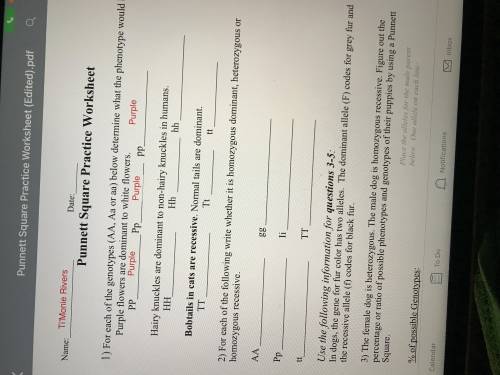HH_ Hh_ hh_

Biology, 08.02.2021 20:40, lebronbangs8930
Punnett square
Hairy knuckles are dominated to non-hairy knuckles in a humans.
HH_ Hh_ hh_


Answers: 3
Other questions on the subject: Biology

Biology, 21.06.2019 19:00, jessieeverett432
If you are in a chronic state of anxiety but also suffer from moment of sudden, intense fear you are problably suffering. from
Answers: 1

Biology, 21.06.2019 22:00, lazavionadams81
Which of the following scenarios is an example of the bottleneck effect? answers a in south africa, much of the afrikaner population is descended from a small number of dutch colonists. in this population, this is an unusually high frequency of pseudoxanthoma elasticum (pxe), an elastic tissue disorder. b four white-tailed deer are introduced to a park in finland. thirty years after their introduction scientists compare the genes in the population and find that there is no variation. c during the industrial revolution, london's air became filled with soot. as a result, birds started eating more of the lighter moths because they were easier to spot than their darker counterparts. over time, the moth population changed so that there were more darker moths than lighter ones. d 10% of the population of american alligators in an area have the recessive trait albinism. a massive flood results in the death of 80% of the population. of the remaining population, 60% have the recessive trait of albinism.
Answers: 2

Biology, 22.06.2019 01:30, eguilford4438
Scenario 5 1) take 10 red and 10 black beans and place them, mixed, on the table. record the starting phenotype # and frequencies (% of your total population) of your starting population in the table provided (generation 0). 2) act as a predator. “capture” as many organisms as you can until you have reduced the population to three organisms. put them aside. at this point, the predators die. 3) the remaining organisms each produce 2 clonal offspring. multiply your organisms accordingly and allow them to mix on the table. calculate and record the resultant phenotype # and frequencies (% of your total population) of your population in the table provided (generation 1). 4) repeat the reproduction event, allowing each of your organisms to produce 2 clonal offspring. calculate and record the resultant phenotype # and frequencies (% of your total population) of your population in the table provided (generation 2). 5) repeat the reproduction event, allowing each of your organisms to produce 2 clonal offspring. calculate and record the resultant phenotype # and frequencies (% of your total population) of your population in the table provided (generation 3).
Answers: 1
Do you know the correct answer?
Punnett square
Hairy knuckles are dominated to non-hairy knuckles in a humans.
HH_ Hh_ hh_
HH_ Hh_ hh_
Questions in other subjects:

History, 26.04.2021 21:20

Mathematics, 26.04.2021 21:20


Mathematics, 26.04.2021 21:20


Mathematics, 26.04.2021 21:20




Mathematics, 26.04.2021 21:20






